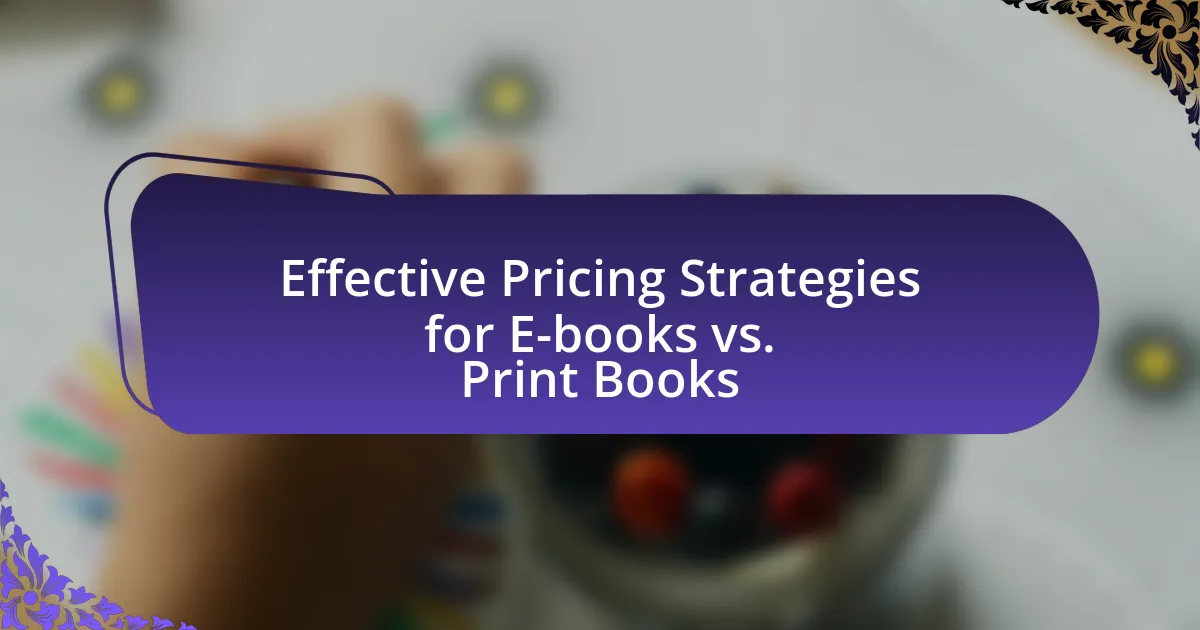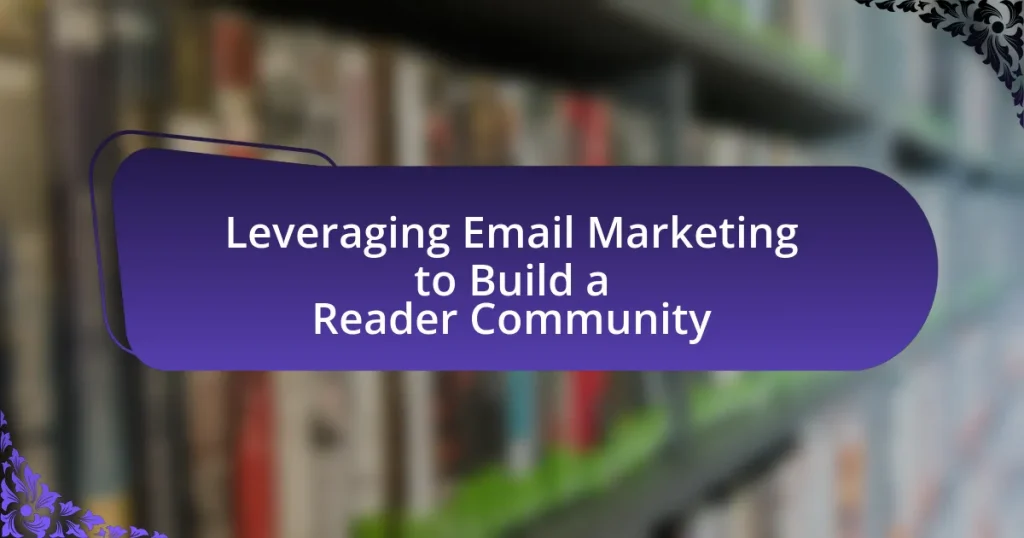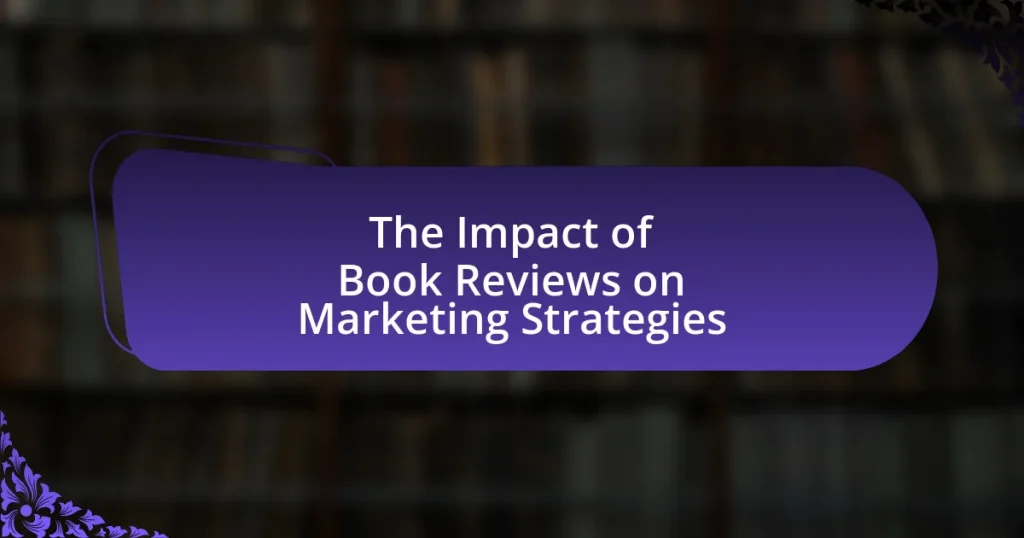The article focuses on effective pricing strategies for e-books compared to print books, highlighting the differences in price points due to production and distribution costs. E-books are typically priced between $2.99 and $9.99, while print books range from $10 to $30, reflecting their tangible nature and associated expenses. Key factors influencing pricing for both formats include production costs, market demand, competition, and perceived value. The article also discusses the impact of pricing on consumer purchasing decisions and author royalties, as well as best practices for optimizing pricing strategies for both e-books and print books.
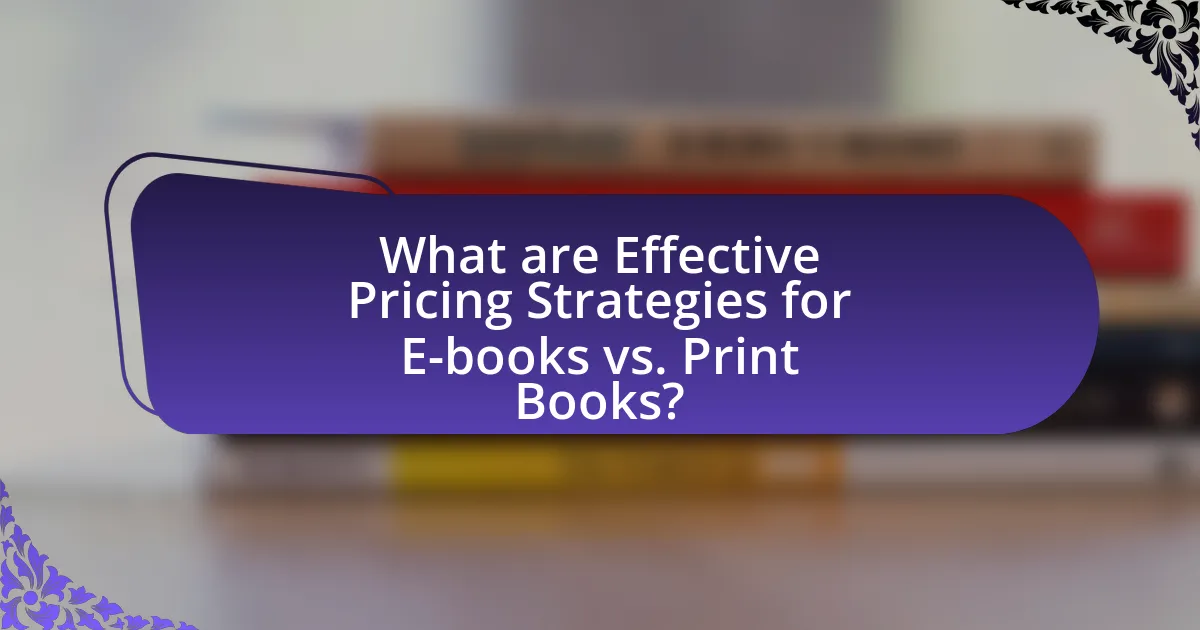
What are Effective Pricing Strategies for E-books vs. Print Books?
Effective pricing strategies for e-books typically involve lower price points compared to print books, reflecting the reduced production and distribution costs associated with digital formats. E-books often range from $2.99 to $9.99, which aligns with consumer expectations for digital content, while print books generally range from $10 to $30, depending on factors like format and genre.
Research indicates that e-books priced between $2.99 and $9.99 tend to maximize sales volume, as this price range is perceived as a good value by consumers. In contrast, print books can leverage higher pricing due to their tangible nature and the associated costs of printing and shipping. Additionally, promotional strategies such as discounts, bundling, and limited-time offers can be effective for both formats, but e-books benefit from the ease of implementing dynamic pricing strategies through online platforms.
The effectiveness of these pricing strategies is supported by data from the Association of American Publishers, which shows that e-book sales have consistently increased when priced competitively against print counterparts.
How do pricing strategies differ between E-books and Print Books?
Pricing strategies for E-books typically involve lower price points compared to Print Books due to reduced production and distribution costs. E-books can be priced between $2.99 and $9.99, while Print Books often range from $10 to $30, reflecting expenses like printing, shipping, and physical retail space. Additionally, E-books allow for dynamic pricing strategies, such as discounts and promotional pricing, which can be adjusted quickly based on market demand or sales performance. In contrast, Print Books generally have more stable pricing due to fixed costs and longer production cycles. This difference is supported by data showing that E-books often sell at a higher volume at lower prices, while Print Books rely on perceived value and physical presence to justify their higher prices.
What factors influence the pricing of E-books?
The pricing of E-books is influenced by factors such as production costs, market demand, competition, and distribution channels. Production costs include expenses related to editing, design, and formatting, which can vary significantly based on the quality and complexity of the E-book. Market demand plays a crucial role, as higher demand can lead to increased prices, while lower demand may necessitate discounts to attract buyers. Competition among publishers and authors also affects pricing strategies; if similar titles are available at lower prices, publishers may need to adjust their pricing to remain competitive. Lastly, distribution channels, including platforms like Amazon or independent websites, can impose fees that influence the final price set by the publisher.
What factors influence the pricing of Print Books?
The pricing of print books is influenced by factors such as production costs, market demand, competition, and distribution expenses. Production costs include printing, paper quality, and binding, which directly affect the retail price. Market demand plays a crucial role; higher demand can lead to increased prices, while lower demand may necessitate discounts. Competition among publishers and retailers also impacts pricing strategies, as they may adjust prices to attract consumers. Additionally, distribution expenses, including shipping and retailer margins, contribute to the final price consumers pay. These factors collectively shape the pricing landscape for print books in the market.
Why is pricing important in the book market?
Pricing is important in the book market because it directly influences consumer purchasing decisions and overall sales volume. Research indicates that price sensitivity varies among different reader demographics, with lower prices often leading to increased sales, particularly in the e-book segment where competition is high. For instance, a study by the Book Industry Study Group found that e-books priced between $2.99 and $9.99 tend to achieve higher sales compared to those priced above this range. Additionally, effective pricing strategies can enhance perceived value, attract new readers, and foster brand loyalty, making it a critical factor for authors and publishers in maximizing revenue and market reach.
How does pricing affect consumer purchasing decisions?
Pricing significantly influences consumer purchasing decisions by directly impacting perceived value and affordability. When consumers perceive a product’s price as too high, they may view it as less valuable or opt for alternatives, while competitive pricing can enhance attractiveness and drive sales. Research indicates that 70% of consumers consider price as a primary factor in their purchasing decisions, highlighting its critical role in market dynamics. Additionally, psychological pricing strategies, such as setting prices just below a round number, can create a perception of a better deal, further affecting consumer behavior.
What role does pricing play in author royalties?
Pricing directly influences author royalties by determining the percentage of sales revenue that authors receive. For instance, traditional publishing contracts often stipulate that authors earn royalties based on a percentage of the book’s retail price, typically ranging from 10% to 15% for print books and up to 25% for e-books. Therefore, a higher retail price can lead to increased royalties, while a lower price may reduce earnings. Additionally, pricing strategies, such as promotional discounts or dynamic pricing, can affect sales volume and ultimately impact total royalties earned. Research indicates that e-books priced between $2.99 and $9.99 tend to maximize royalties for authors, as this price range aligns with higher sales volume and favorable royalty percentages.
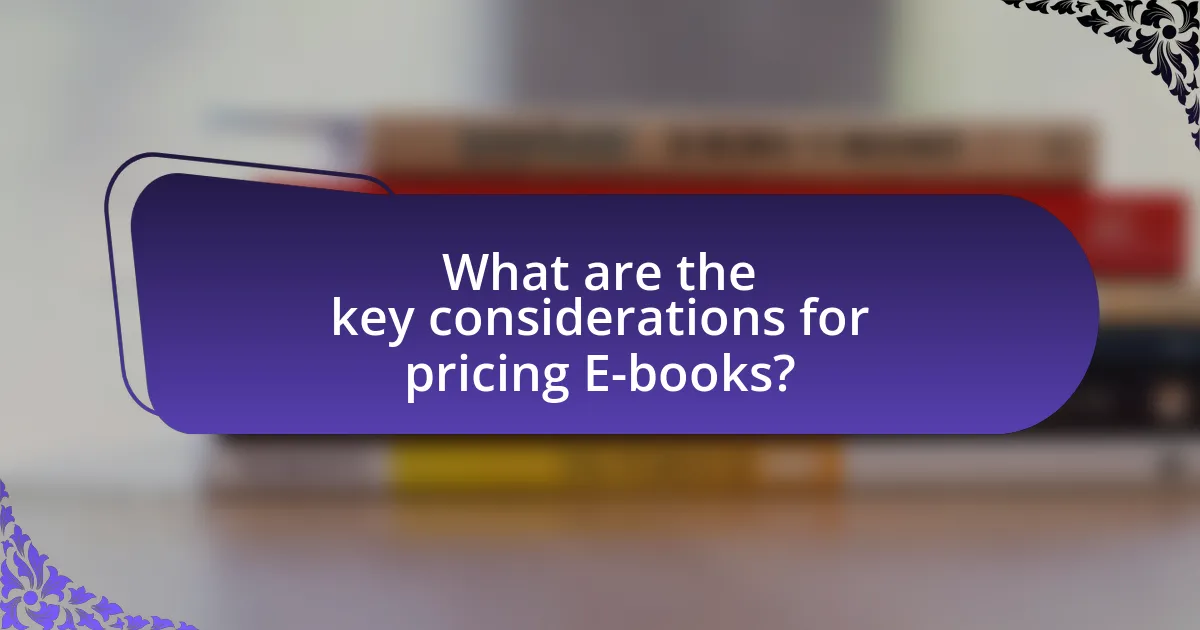
What are the key considerations for pricing E-books?
The key considerations for pricing E-books include production costs, market demand, competition, and perceived value. Production costs encompass expenses related to editing, design, and distribution, which can influence the minimum price point. Market demand is assessed through reader preferences and trends, as higher demand may justify a higher price. Competition analysis involves comparing similar E-books in the genre to ensure pricing remains competitive while maximizing profit. Lastly, perceived value is shaped by factors such as author reputation and unique content, which can allow for premium pricing. These considerations collectively inform a strategic pricing approach that aligns with both market conditions and consumer expectations.
How do production costs impact E-book pricing?
Production costs significantly influence E-book pricing by determining the minimum price at which a publisher can sell the book while still covering expenses. Lower production costs, such as minimal formatting and distribution expenses, allow publishers to set competitive prices, often resulting in E-books being priced lower than print books. For instance, the average production cost for an E-book can be around $1,000 to $3,000, compared to $5,000 to $10,000 for print books, which includes printing and shipping costs. This cost disparity enables publishers to offer E-books at prices that can range from $0.99 to $9.99, making them more accessible to consumers and driving higher sales volumes.
What are the typical costs associated with E-book production?
The typical costs associated with E-book production range from $500 to $5,000, depending on various factors such as formatting, cover design, and editing. Formatting an E-book can cost between $100 and $1,500, while professional cover design typically ranges from $200 to $1,500. Editing services can add another $300 to $2,000, depending on the manuscript’s length and complexity. These costs reflect industry standards and can vary based on the service provider’s expertise and the project’s specific requirements.
How do distribution platforms affect E-book pricing?
Distribution platforms significantly influence E-book pricing by determining the pricing models and commission structures that authors and publishers must navigate. For instance, platforms like Amazon Kindle Direct Publishing take a percentage of sales, which can lead to higher retail prices to maintain profit margins. Additionally, these platforms often set pricing guidelines that can restrict how low or high an E-book can be priced, impacting overall market pricing strategies. Research indicates that E-books priced between $2.99 and $9.99 tend to perform better on platforms like Amazon due to their royalty structures, which incentivize authors to price within this range to maximize earnings.
What pricing models are commonly used for E-books?
Common pricing models for E-books include fixed pricing, dynamic pricing, subscription models, and pay-per-download. Fixed pricing involves setting a specific price for the E-book, which remains constant. Dynamic pricing adjusts the price based on demand, competition, or time, allowing for flexibility. Subscription models, such as Kindle Unlimited, provide access to a library of E-books for a monthly fee, appealing to avid readers. Pay-per-download charges consumers for each individual E-book purchased. These models reflect trends in consumer behavior and market dynamics, with fixed pricing being the most traditional approach, while subscription models have gained popularity in recent years due to their convenience and value.
What is the subscription model for E-books?
The subscription model for E-books allows users to access a library of digital books for a recurring fee, typically monthly or annually. This model provides readers with the flexibility to read multiple titles without purchasing each one individually, often appealing to avid readers and those seeking cost-effective options. Companies like Kindle Unlimited and Scribd exemplify this model, offering subscribers access to thousands of titles for a flat rate, which can lead to increased reading volume and customer retention. According to a report by Statista, the global e-book subscription market is projected to grow significantly, indicating a rising trend in consumer preference for subscription services over traditional purchasing methods.
How does the pay-per-download model work for E-books?
The pay-per-download model for E-books allows consumers to purchase and download individual E-books for a set price, typically ranging from a few dollars to around twenty dollars, depending on the title and publisher. This model enables authors and publishers to monetize their digital content directly, as each download generates revenue without the need for physical inventory or distribution costs. According to a report by the Association of American Publishers, digital book sales in the U.S. reached approximately $1.1 billion in 2020, highlighting the effectiveness of this pricing strategy in the market.
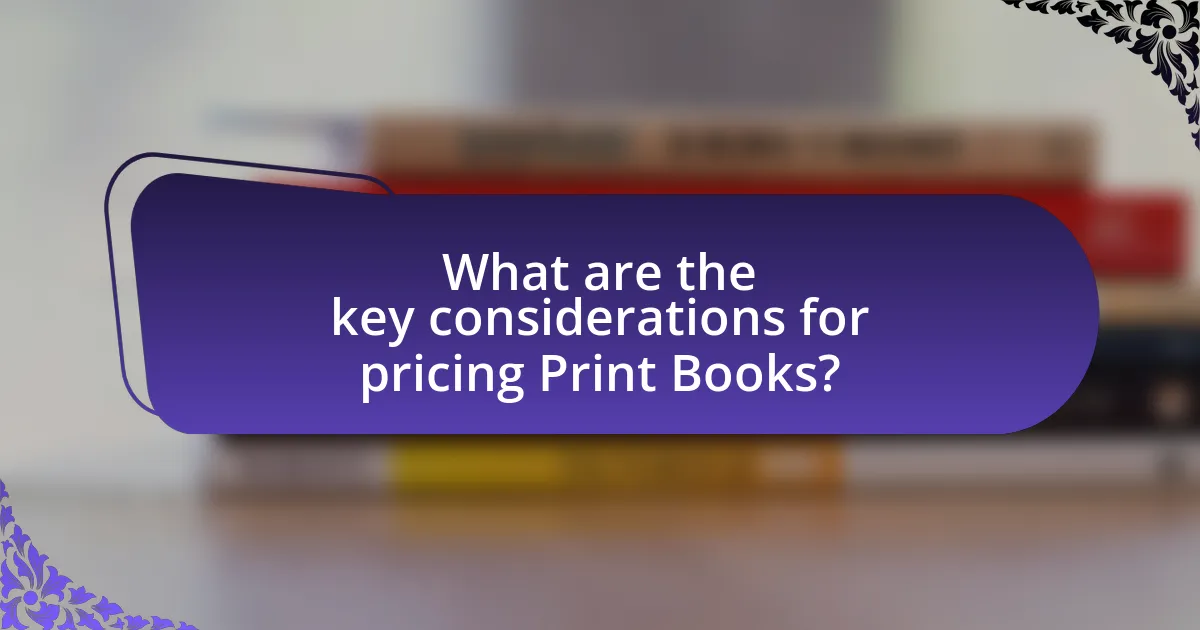
What are the key considerations for pricing Print Books?
The key considerations for pricing print books include production costs, market demand, competition, and perceived value. Production costs encompass printing, binding, and distribution expenses, which directly influence the minimum price point. Market demand is assessed through target audience analysis and sales trends, indicating how much consumers are willing to pay. Competition requires evaluating similar titles in the genre and their pricing strategies to remain competitive. Lastly, perceived value involves understanding how readers view the quality and uniqueness of the book, which can justify higher pricing. These factors collectively inform a strategic pricing approach that aligns with both costs and market expectations.
How do production costs impact Print Book pricing?
Production costs significantly influence print book pricing by determining the minimum price at which a publisher can sell a book while still covering expenses. These costs include materials, printing, binding, and distribution, which collectively affect the overall cost structure. For instance, a study by the Book Industry Study Group indicates that production costs can account for up to 40% of the retail price of a print book. Consequently, higher production costs necessitate higher retail prices to maintain profitability, while lower production costs can allow for more competitive pricing.
What are the typical costs associated with Print Book production?
The typical costs associated with print book production include expenses for printing, paper, binding, cover design, and distribution. Printing costs can vary significantly based on the number of copies produced, with bulk printing generally reducing the per-unit cost. For example, printing a standard paperback can range from $2 to $5 per copy, depending on factors such as page count and color usage. Paper costs also fluctuate based on quality and type, while binding methods, such as perfect binding or hardcover, can add $1 to $3 per book. Cover design can range from $100 to $1,500, depending on the designer’s experience and complexity of the design. Distribution costs, including shipping and retailer discounts, can further impact the overall production budget, often accounting for 20% to 50% of the retail price.
How do physical distribution and retail markups affect Print Book pricing?
Physical distribution and retail markups significantly influence print book pricing by adding costs that publishers must account for in their pricing strategies. The logistics of physical distribution, including shipping, warehousing, and handling, contribute to the overall expenses incurred before a book reaches the retailer. For instance, a study by the Book Industry Study Group indicates that distribution costs can account for up to 30% of the retail price of a print book.
Additionally, retail markups, which can range from 30% to 50% of the wholesale price, further elevate the final consumer price. Retailers apply these markups to cover their operational costs and profit margins. Consequently, the combined effect of distribution costs and retail markups results in higher pricing for print books compared to e-books, which typically have lower overhead costs.
What pricing strategies are effective for Print Books?
Effective pricing strategies for print books include competitive pricing, value-based pricing, and discount pricing. Competitive pricing involves setting prices based on what similar books in the market are selling for, ensuring that the book remains attractive to potential buyers. Value-based pricing focuses on the perceived value of the book to the reader, allowing authors and publishers to set higher prices if the content is unique or highly sought after. Discount pricing, such as offering promotional discounts or bundling with other products, can stimulate sales and attract price-sensitive customers. Research indicates that books priced between $15 and $25 often see higher sales volumes, as this range aligns with consumer expectations for quality print books.
How does bundling affect Print Book pricing?
Bundling typically lowers the pricing of print books by offering multiple titles or products together at a discounted rate. This strategy encourages consumers to purchase more items simultaneously, which can increase overall sales volume. For instance, research indicates that bundled offers can lead to a price reduction of 10-30% compared to purchasing items individually, making the combined package more attractive to buyers. Additionally, bundling can enhance perceived value, as customers feel they are receiving more for their money, thus driving higher sales for publishers and retailers.
What is the impact of discounts and promotions on Print Book sales?
Discounts and promotions significantly increase print book sales by attracting price-sensitive consumers and stimulating demand. Research indicates that promotional pricing can lead to a sales uplift of 20% to 50% during discount periods, as consumers are more likely to purchase when they perceive a bargain. For instance, a study by the Book Industry Study Group found that 60% of consumers reported being influenced by discounts when deciding to buy a print book. This demonstrates that strategic pricing tactics, such as limited-time offers or bundling, can effectively drive higher sales volumes in the print book market.
How can authors optimize their pricing strategies for both formats?
Authors can optimize their pricing strategies for both e-books and print books by conducting market research to understand consumer preferences and price sensitivity. By analyzing competitors’ pricing, authors can set competitive prices that attract readers while ensuring profitability. Additionally, implementing tiered pricing strategies, such as offering discounts for bulk purchases or promotional pricing during launch periods, can enhance sales across both formats. Research indicates that e-books typically have lower production costs, allowing for more flexible pricing strategies compared to print books, which incur higher costs for printing and distribution. Therefore, authors should consider these cost structures when determining their pricing to maximize revenue and reach a broader audience.
What are best practices for setting competitive prices for E-books?
The best practices for setting competitive prices for E-books include conducting market research, analyzing competitor pricing, and understanding the target audience’s willingness to pay. Market research reveals that E-books typically range from $2.99 to $9.99, with many successful titles priced around $4.99, which aligns with consumer expectations and purchasing behavior. Analyzing competitor pricing helps identify price points that attract readers while maintaining profitability. Additionally, understanding the target audience’s preferences and price sensitivity can guide pricing strategies, ensuring that the E-book is perceived as valuable. These practices are supported by data indicating that E-books priced within the $2.99 to $9.99 range tend to achieve higher sales volumes, as reported by the Author Earnings report.
What are best practices for setting competitive prices for Print Books?
To set competitive prices for print books, authors and publishers should conduct thorough market research to analyze similar titles in their genre, considering factors such as production costs, target audience, and distribution channels. This approach ensures that the pricing aligns with consumer expectations and market standards. For instance, a study by the Book Industry Study Group found that the average price for a hardcover book in the U.S. was around $27, while paperbacks averaged $16, indicating a clear pricing structure within the industry. Additionally, implementing psychological pricing strategies, such as setting prices just below a round number (e.g., $19.99 instead of $20), can enhance perceived value and attract more buyers.
